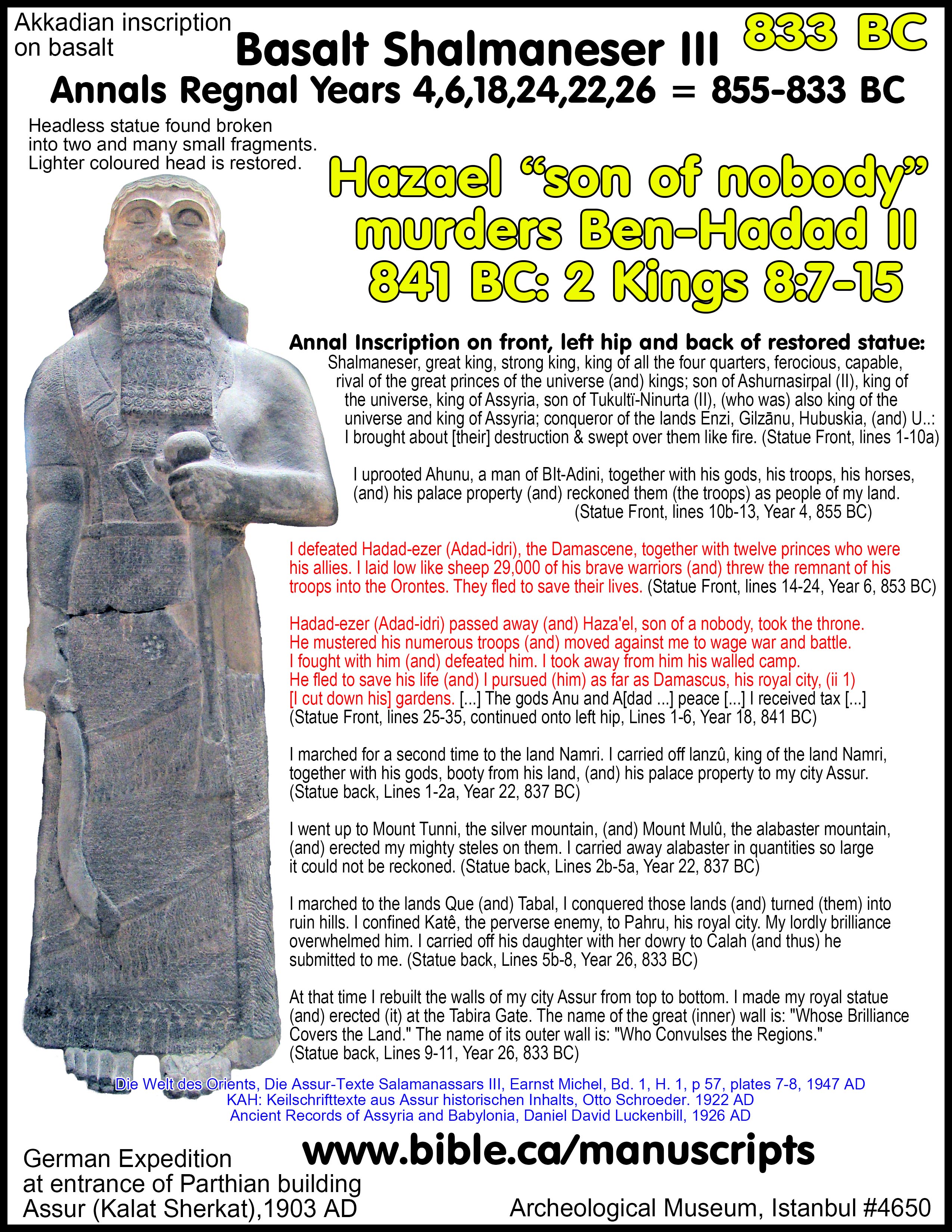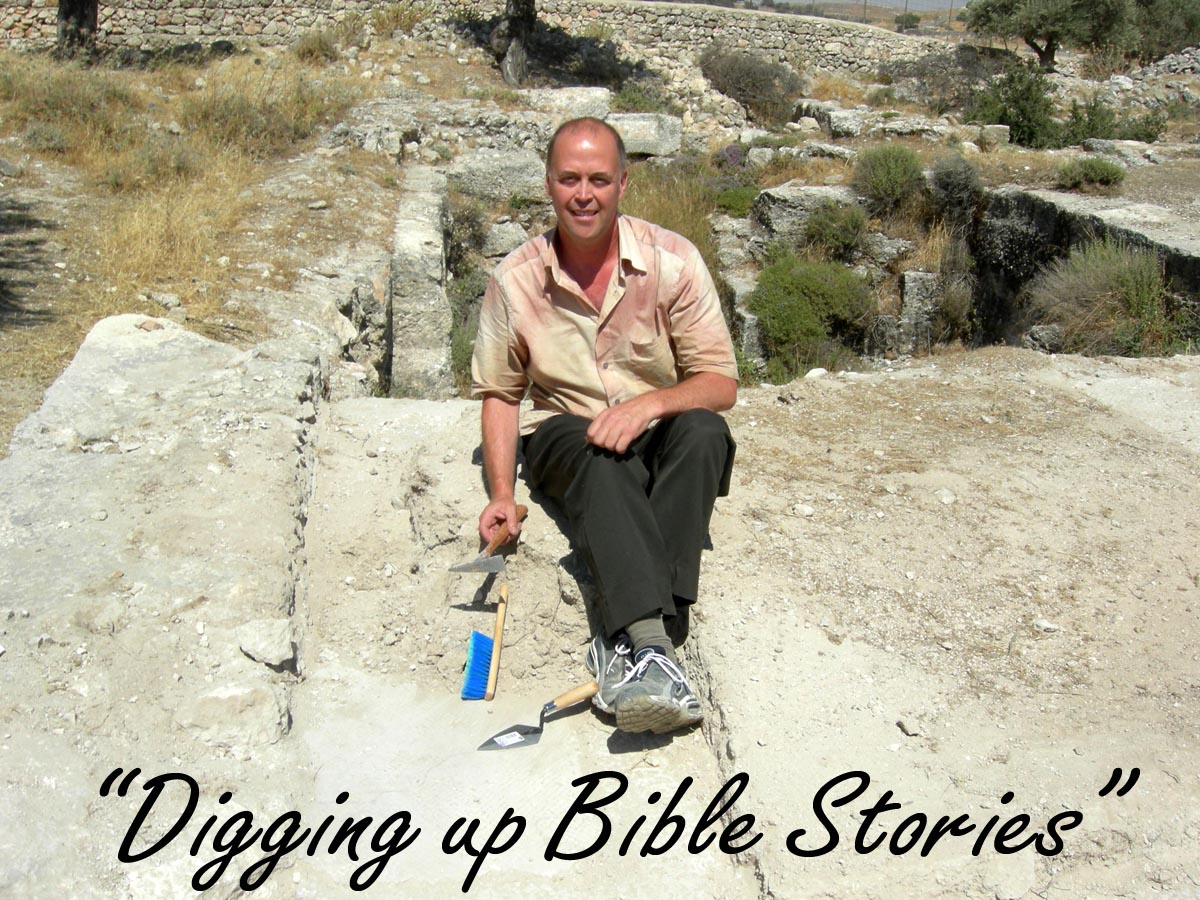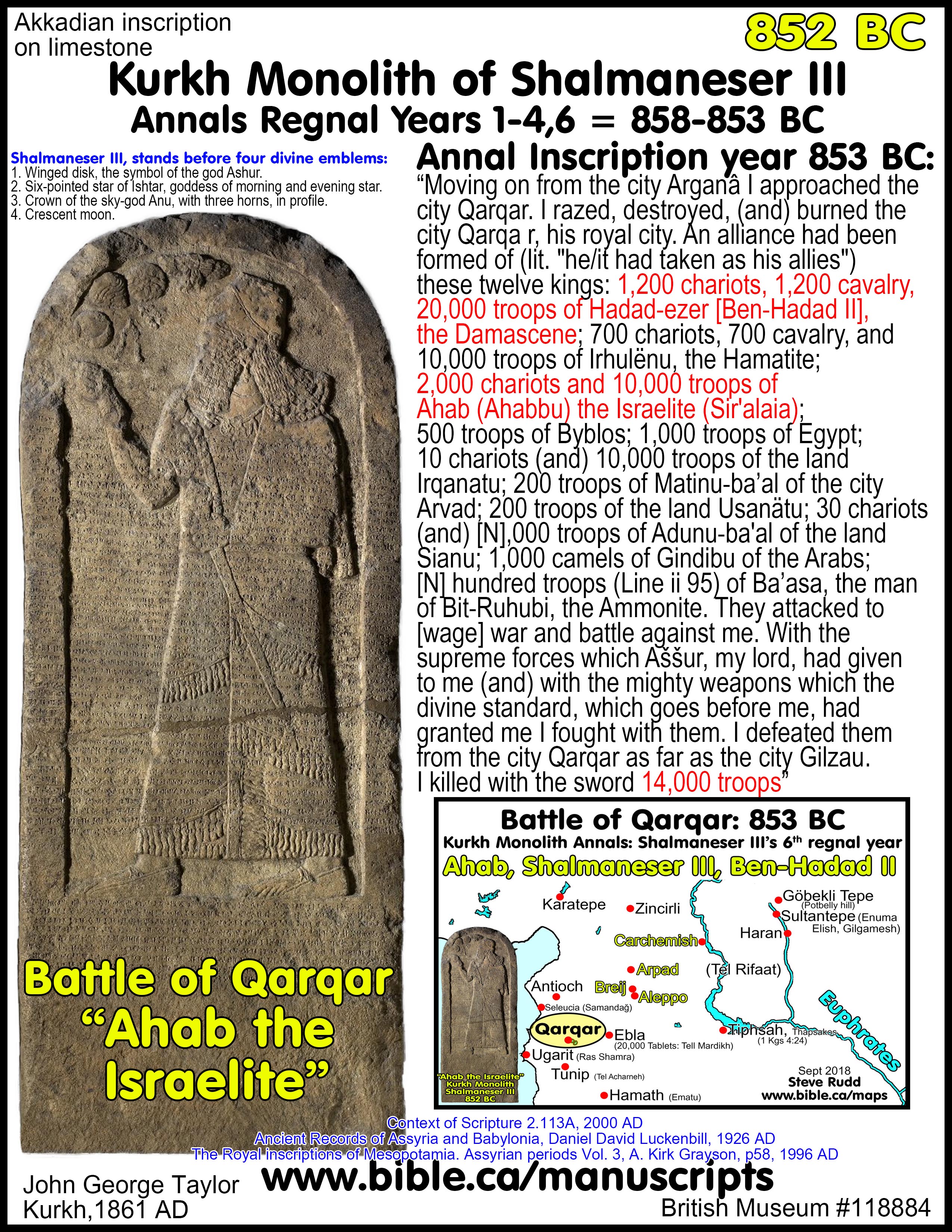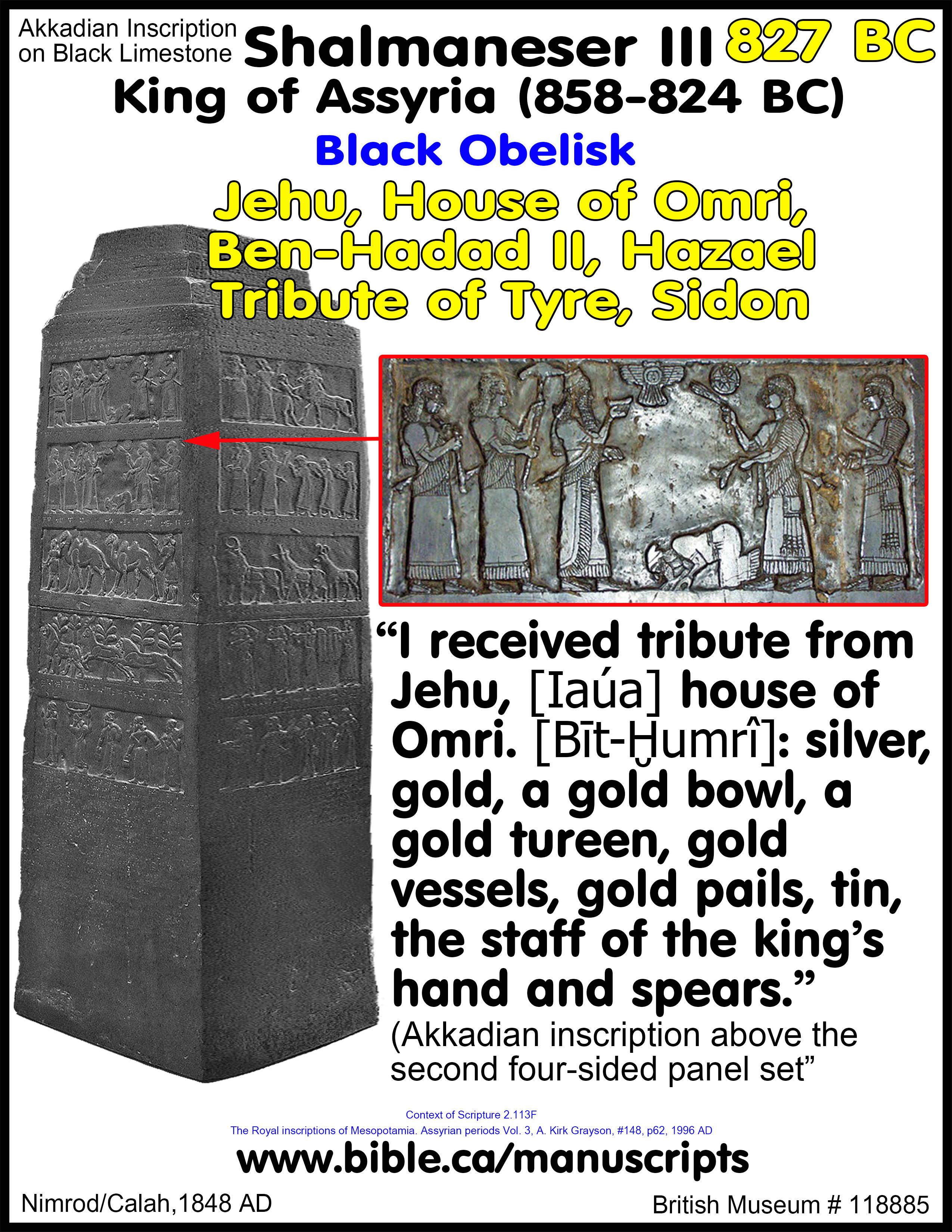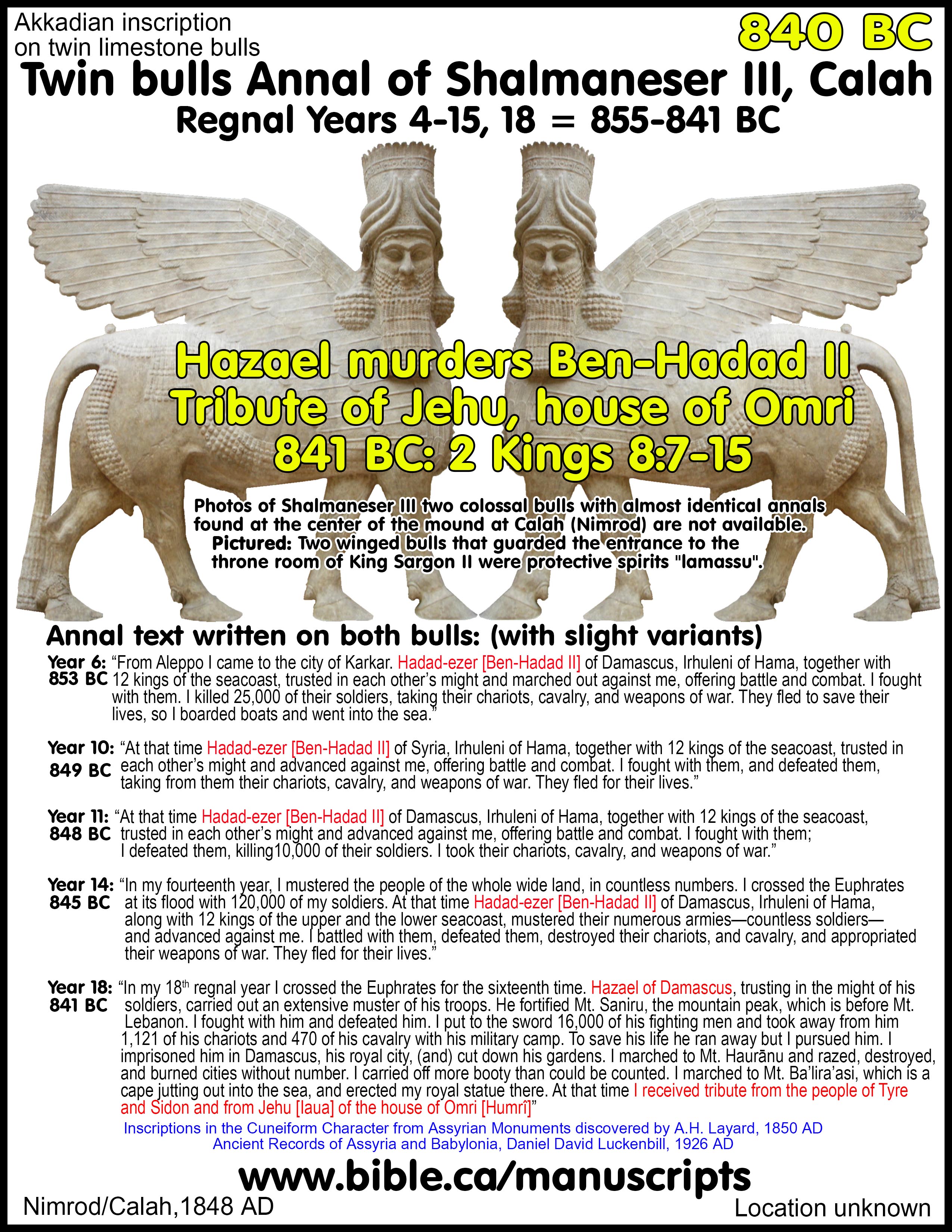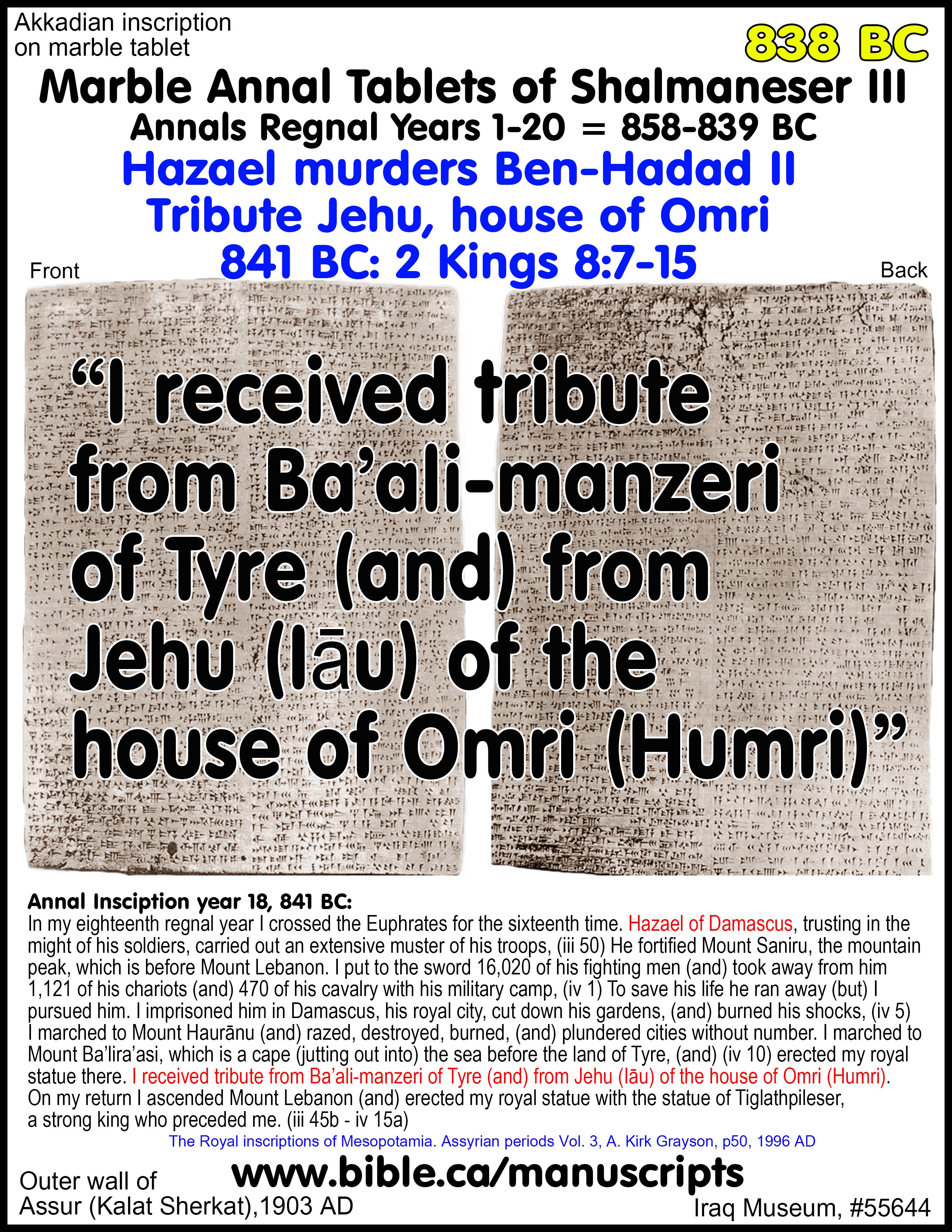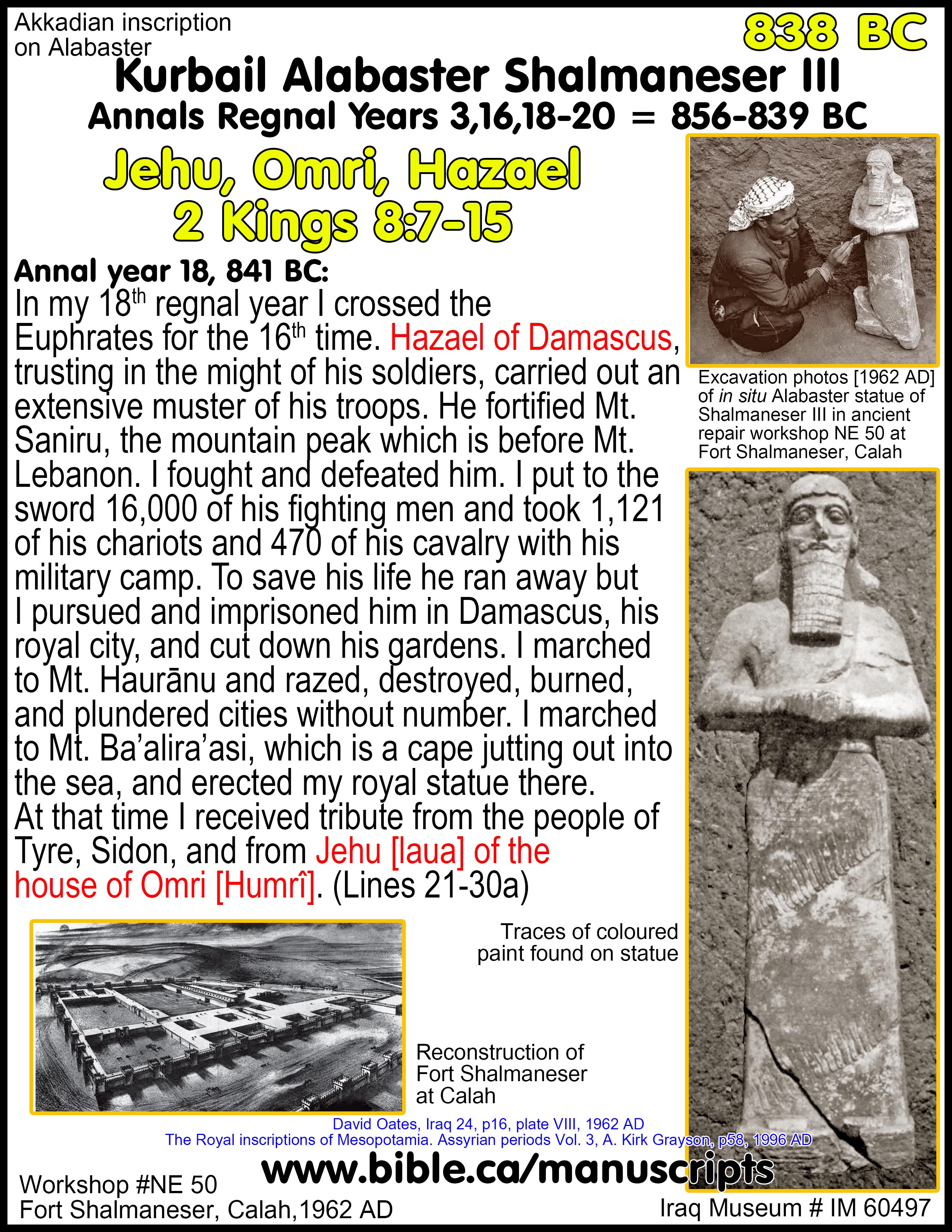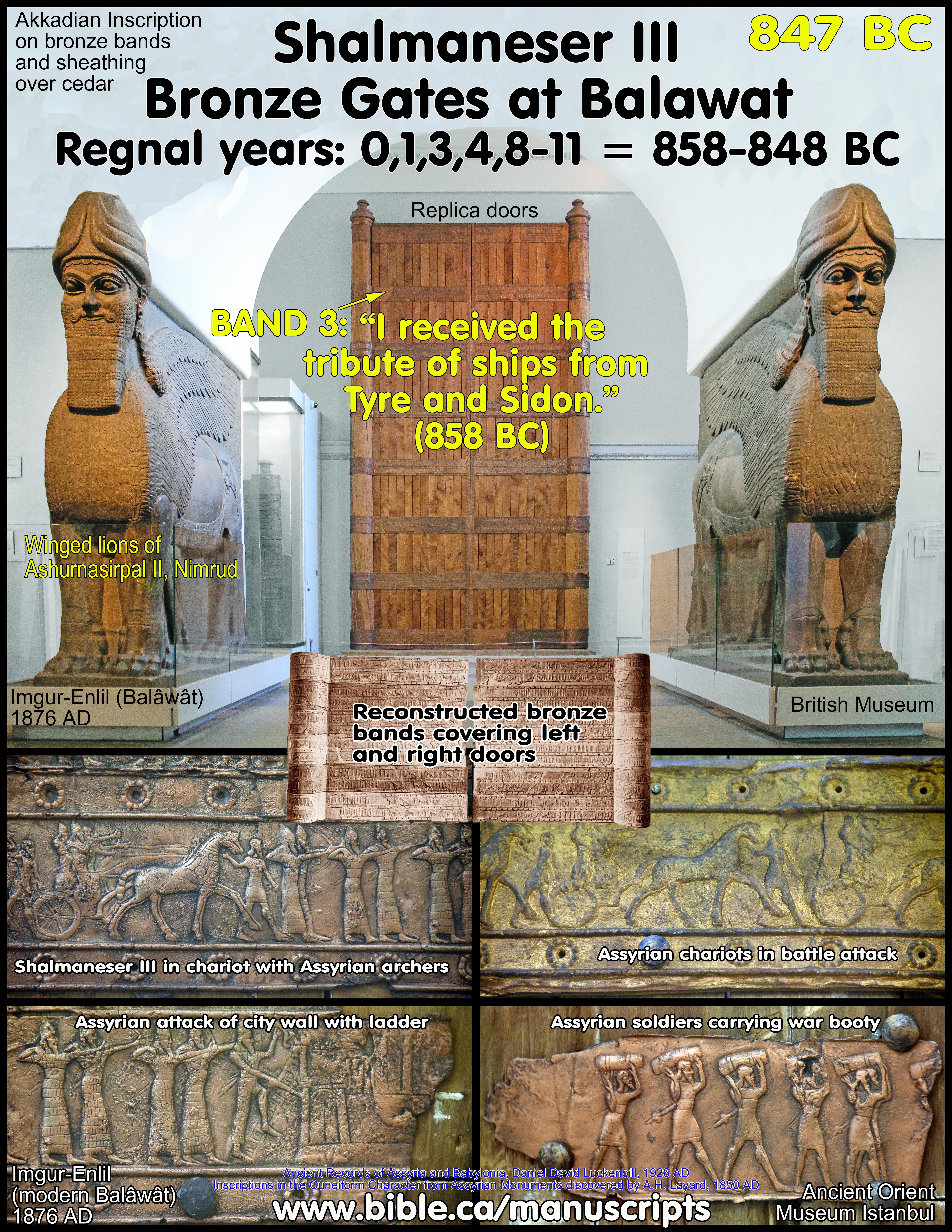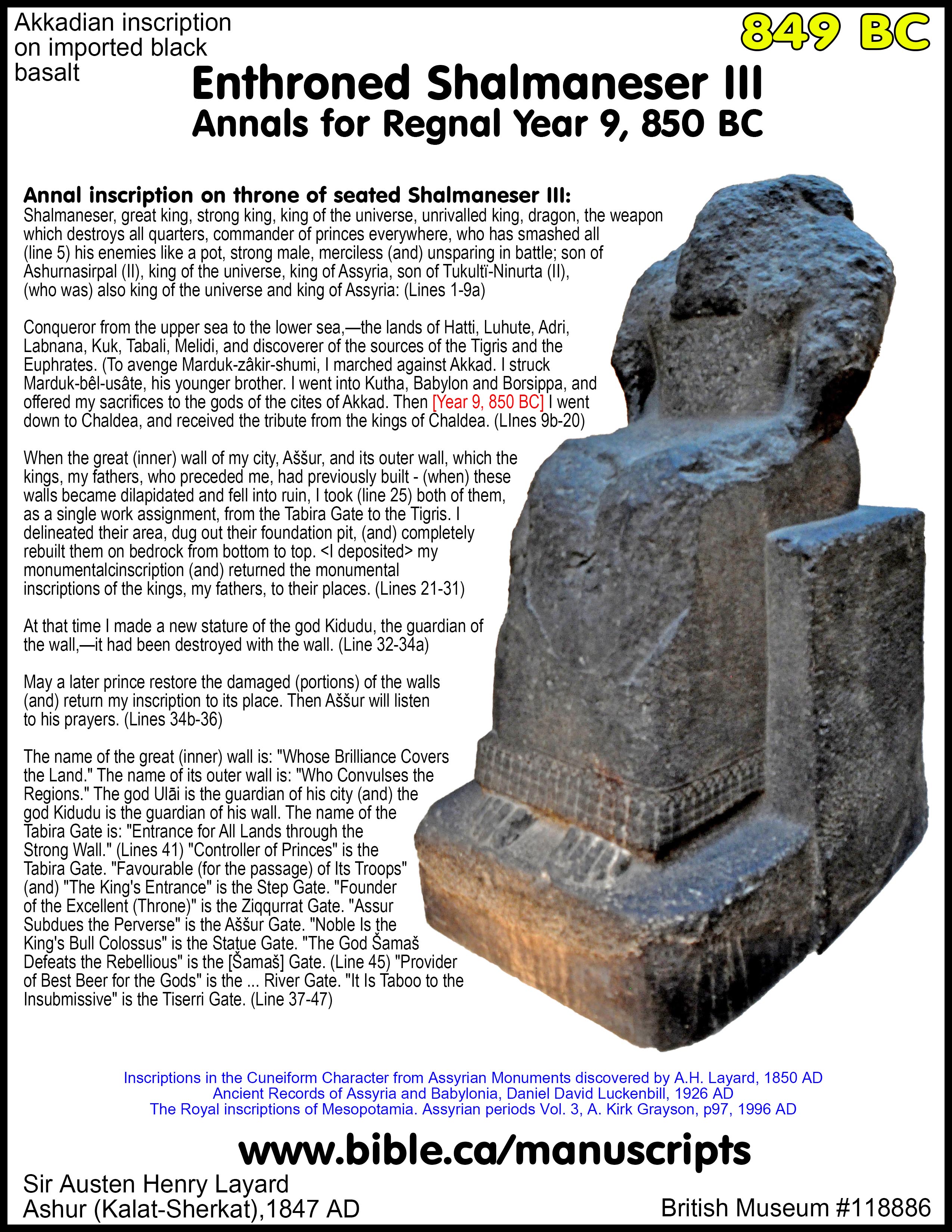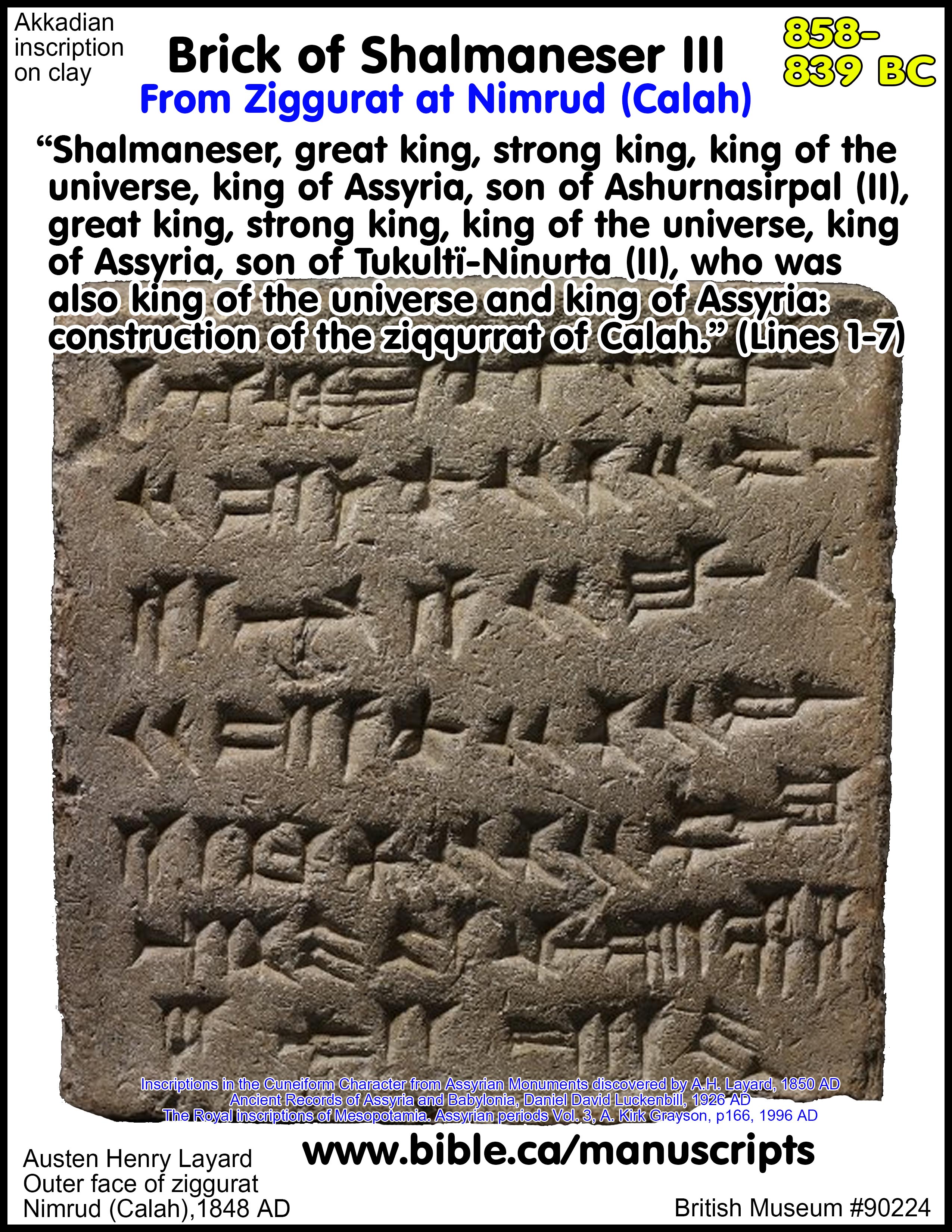Basalt statue of Shalmaneser III: 833 BC
Shalmaneser III, King of Assyria 858-824 BC
“Ben-Hadad II, Hazael, son of nobody”: 2 Kings 8:7-15
See also: Detailed outline on Shalmaneser III
|
Basalt statue of Shalmaneser III Detailed outline on Shalmaneser III Headless statue found broken into two and many small fragments. Lighter coloured head is restored. |
|
|
Date of inscription |
833 BC |
|
Annal years |
855-833 BC |
|
Glyptic object |
Akkadian inscription on Basalt |
|
Discovery |
German Expedition at entrance of Parthian building Assur (Kalat Sherkat),1903 AD |
|
Current location |
Archeological Museum, Istanbul #4650 |
|
Bible names |
Hazael, Ben Hadad II |
|
Historic events |
Hazael “son of nobody” murders Ben-Hadad II in 841 BC: 2 Kings 8:7-15 |
|
Digging up Bible stories! “I defeated Hadad-ezer (Adad-idri) [Ben-Hadad II], the Damascene, together with twelve princes who were his allies.” (Statue Front, lines 14-24, Year 6, 853 BC)
“Hadad-ezer (Adad-idri) [Ben-Hadad II] passed away (and) Hazael, son of a nobody, took the throne. He mustered his numerous troops (and) moved against me to wage war and battle. I fought with him (and) defeated him.” (Statue Front, lines 25-35, continued onto left hip, Lines 1-6, Year 18, 841 BC)
"What we read in the book, we find in the ground" |
Introduction:
1. Importance of the basalt statue of Shalmaneser III for Bible students:
a. The basalt statue of Shalmaneser III directly confirms the Bible account in 2 Kings 8:7-15 of how Hazael seized the throne from outside the royal bloodline.
b. Two times Shalmaneser III defeated the twelve kings (which includes Ahab) that were led by Ben Hadad II.
2. The Bible story:
a. "Then Elisha came to Damascus. Now Ben-hadad king of Aram was sick, and it was told him, saying, “The man of God has come here.” The king said to Hazael, “Take a gift in your hand and go to meet the man of God, and inquire of the Lord by him, saying, ‘Will I recover from this sickness?’ ” So Hazael went to meet him and took a gift in his hand, even every kind of good thing of Damascus, forty camels’ loads; and he came and stood before him and said, “Your son Ben-hadad king of Aram has sent me to you, saying, ‘Will I recover from this sickness?’ ” Then Elisha said to him, “Go, say to him, ‘You will surely recover,’ but the Lord has shown me that he will certainly die.” He fixed his gaze steadily on him until he was ashamed, and the man of God wept. Hazael said, “Why does my lord weep?” Then he answered, “Because I know the evil that you will do to the sons of Israel: their strongholds you will set on fire, and their young men you will kill with the sword, and their little ones you will dash in pieces, and their women with child you will rip up.” Then Hazael said, “But what is your servant, who is but a dog, that he should do this great thing?” And Elisha answered, “The Lord has shown me that you will be king over Aram.” So he departed from Elisha and returned to his master, who said to him, “What did Elisha say to you?” And he answered, “He told me that you would surely recover.” On the following day, he took the cover and dipped it in water and spread it on his face, so that he died. And Hazael became king in his place." (2 Kings 8:7–15)
3. Headless statue found broken into two and many small fragments. Lighter coloured head is restored.
4. Two of the six battles with Israel:
a.
853 BC, year 6. The battle of Qarqar where Shalmaneser III warred against Ben-Hadad II and
his coalition of 12 kings, one of whom was Ahab: “I defeated
Hadad-ezer (Adad-idri), the Damascene, together with twelve princes who were
his allies. I laid low like sheep 29,000 of his brave warriors (and) threw the
remnant of his troops into the Orontes. They fled to save their lives.”
(Statue Front, lines 14-24, Year 6, 853 BC)
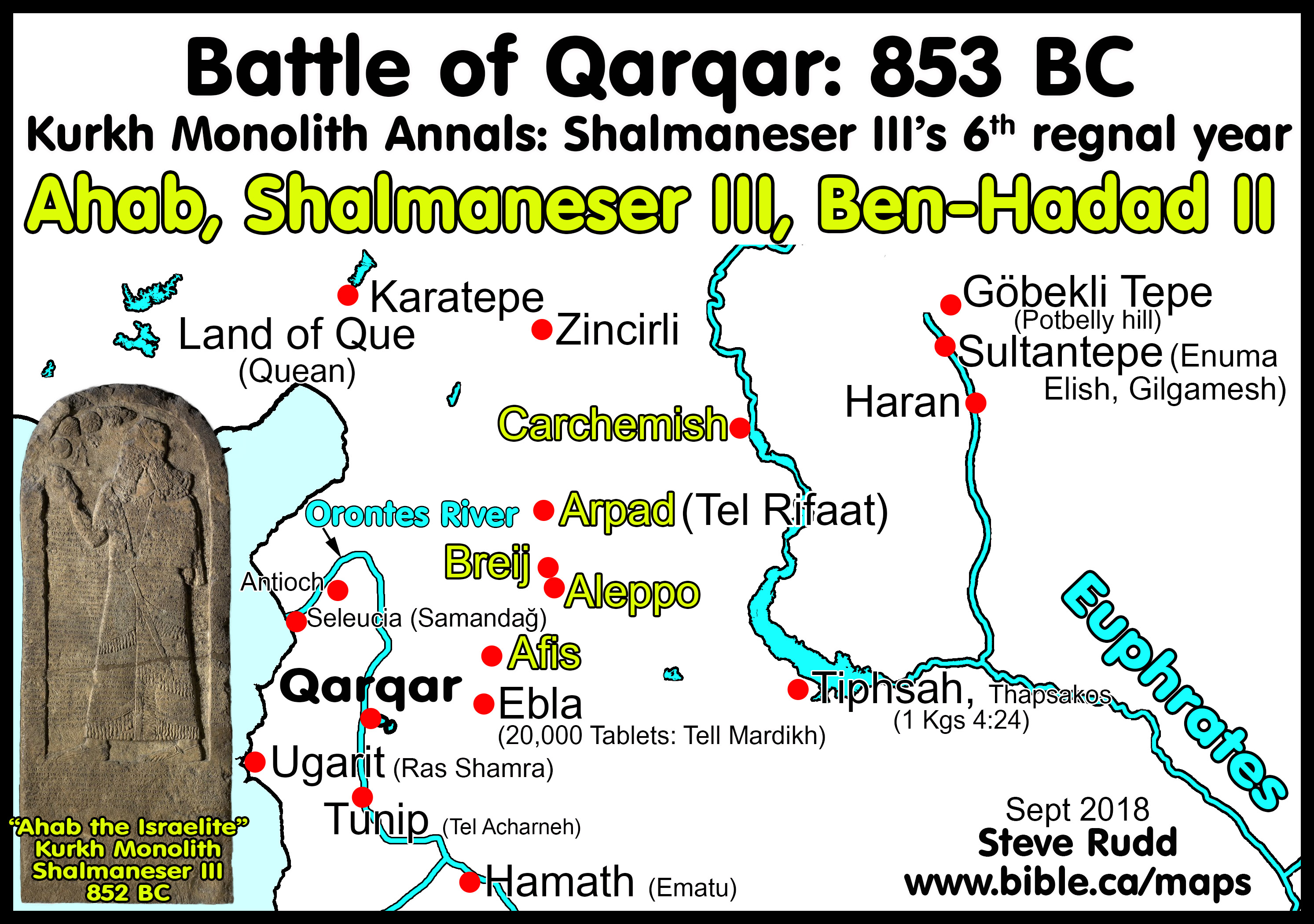
b. 841 BC, Year 18: Siege of Damascus: against Hazael: “Hadad-ezer (Adad-idri) [Ben-Hadad II] passed away (and) Hazael, son of a nobody, took the throne. He mustered his numerous troops (and) moved against me to wage war and battle. I fought with him (and) defeated him. I took away from him his walled camp. He fled to save his life (and) I pursued (him) as far as Damascus, his royal city, (ii 1) [I cut down his] gardens. [...] The gods Anu and A[dad ...] peace [...] I received tax [...] (Statue Front, lines 25-35, continued onto left hip, Lines 1-6, Year 18, 841 BC)”
5. Sources:
a. Die Welt des Orients, Die Assur-Texte Salamanassars III, Earnst Michel, Bd. 1, H. 1, p 57, plates 7-8, 1947 AD
b. KAH: Keilschrifttexte aus Assur historischen Inhalts, Otto Schroeder. 1922 AD
c. Ancient Records of Assyria and Babylonia, Daniel David Luckenbill, 1926 AD
6. See Detailed outline on Shalmaneser III
I. About the Basalt statue of Shalmaneser III:
1. “This text is engraved on a broken [headless] statue of Shalmaneser discovered at Assur by the German expedition in 1903. It was found at the entrance to a Parthian building, where it had been moved from its original location at the Tabira Gate (iii 10). The statue was broken into two large and many small pieces, and its head was missing. The monument has been repaired and is now on display in the Archaeological Museum, Istanbul. The text begins (i 1-9) with the royal name, epithets, and a general overview of conquests. This is followed by descriptions of several campaigns, not in strict chronological order. Specifically, campaigns of the following years are mentioned: fourth in 855 BC (i 10-13), sixth in 853 BC (i 14-24), eighteenth in 841 BC (i 25 - ii 1), unknown (ii 2-6), twenty-fourth in 835 BC (iii 1), twenty-second in 837 BC (iii 2-4), and twenty-sixth in 833 BC (iii 5-8). Thus the text must date to 833 BC or shortly thereafter. The statue and inscription were created to commemorate the restoration of the inner and outer walls of Aššur (iii 9-11). There are no concluding blessings or curses.” (The Royal inscriptions of Mesopotamia. Assyrian periods Vol. 3, A. Kirk Grayson, p117, 1996 AD)
2. COMMENTARY The statue (E§ 4650, Ass 742, Ass ph 438-45, 461-69, 482-83, and 489-92), when complete with the head, must have stood about 250 cm high. It was found at the entrance to the inner Parthian Peribolos on the east level, iA5I. The inscription has been collated from numerous photos. The text is engraved on three surfaces, the front ("i"), the left hip ("ii"), and the back ("iii"). For convenience I have followed Messerschmidfs designation as "i," "ii," and "iii."” (The Royal inscriptions of Mesopotamia. Assyrian periods Vol. 3, A. Kirk Grayson, p117, 1996 AD)
II. Translation of the Basalt statue of Shalmaneser III:
|
Date Regnal Year Nisan |
Translated text |
|
Jan 858 BC Year 0 intro |
Shalmaneser, great king, strong king, king of all the four quarters, ferocious, capable, rival of the great princes of the universe (and) kings; son of Ashurnasirpal (II), king of the universe, king of Assyria, son of Tukultď-Ninurta (II), (who was) also king of the universe and king of Assyria; conqueror of the lands Enzi, Gilzānu, Hubuskia, (and) U...: I brought about [their] destruction and swept over them like fire. (Statue Front, lines 1-10a, intro)
|
|
855 BC Year 4 |
I uprooted Ahunu, a man of BIt-Adini, together with his gods, his troops, his horses, (and) his palace property (and) reckoned them (the troops) as people of my land. (Statue Front, lines 10b-13, Year 4, 855 BC)
|
|
853 BC Year 6 Battle of Qarqar with Ben-Hadad II and 12 kings. Eponymy of Daiiān-Aššur
|
I defeated Hadad-ezer (Adad-idri), the Damascene, together with twelve princes who were his allies. I laid low like sheep 29,000 of his brave warriors (and) threw the remnant of his troops into the Orontes. They fled to save their lives. (Statue Front, lines 14-24, Year 6, 853 BC)
|
|
841 BC Year 18 War with Hazael |
Hadad-ezer (Adad-idri) [Ben-Hadad II] passed away (and) Hazael, son of a nobody, took the throne. He mustered his numerous troops (and) moved against me to wage war and battle. I fought with him (and) defeated him. I took away from him his walled camp. He fled to save his life (and) I pursued (him) as far as Damascus, his royal city, (ii 1) [I cut down his] gardens. [...] The gods Anu and A[dad ...] peace [...] I received tax [...] (Statue Front, lines 25-35, continued onto left hip, Lines 1-6, Year 18, 841 BC)
|
|
837 BC Year 22 |
I marched for a second time to the land Namri. I carried off lanzű, king of the land Namri, together with his gods, booty from his land, (and) his palace property to my city Assur. (Statue back, Lines 1-2a, Year 22, 837 BC) |
|
833 BC Year 26 |
I marched to the lands Que (and) Tabal, I conquered those lands (and) turned (them) into ruin hills. I confined Katę, the perverse enemy, to Pahru, his royal city. My lordly brilliance overwhelmed him. I carried off his daughter with her dowry to Calah (and thus) he submitted to me. (Statue back, Lines 5b-8, Year 26, 833 BC)
At that time I rebuilt the walls of my city Assur from top to bottom. I made my royal statue (and) erected (it) at the Tabira Gate. The name of the great (inner) wall is: "Whose Brilliance Covers the Land." The name of its outer wall is: "Who Convulses the Regions." (Statue back, Lines 9-11, Year 26, 833 BC) |
Conclusion:
1. The basalt statue of Shalmaneser III directly confirms the Bible account in 2 Kings 8:7-15 of how Hazael seized the throne from outside the royal bloodline.
2. Two of the six battles between Israel and Assyria: It highlights the ongoing battles between Shalmaneser III of Assyria and the coalition of 12 kings under the command of Ben-Hadad II of Aram (Damascus) which included three Israeli kings: Ahab, Jehoram and Jehu.
a. 853 BC, year 6. The battle of Qarqar
b. 841 BC, Year 18: Siege of Damascus
3. What you read in the book, you find in the ground! Find me a church to attend in my home town this Sunday!
|
Shalmaneser III |
||
|
|
|
|
|
|
|
|
By Steve Rudd: Contact the author for comments, input or corrections.
